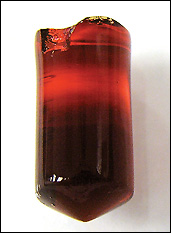Bioengineers, biomedical engineers, medical device designers, doctors and other medical and biotechnology professionals rely on materials scientists to help with design and synthesis of new materials and materials systems that are suitable for medical implants. This could include bio-inorganic hybrid systems such as BioMEMS, implants (such as dental materials, cardiac stents made of shape memory alloys, and drug releasing hydrogels), and biomimetic systems, which can mimic the functioning of biological systems.
Many of the challenges in producing new medical devices and medical implants center around materials. There's no shortage of innovative ideas, but they can't become reality without biocompatible, functional materials. If you want to be at the foundation of bioengineering and biomedical engineering, materials science is a great place to be!
Creating Longer-Lasting Joint Replacements: MSE Professor S. Ankem has developed a technique in which "micropores" are made on the surface of a metal bone implant such as a replacement hip joint. The tiny indentations create a much larger surface area for the patient's bone cells to cling to, which results in the implant staying in place and functioning longer. More...
Improving MRI (Magnetic Resonance Imaging) and X-Ray Technology: Professor Oded Rabin is improving contrast agents, the chemicals given to a patient before an imaging procedure to help improve the quality of the images. His new contrast agents are made out of tiny nanoparticles that can be suspended in serum or inhaled as aerosols, and travel through the body to the specific organ doctors would like to image. The nanoparticle agents can also dramatically improve the capabilities of existing technology: Dr. Rabin has devised a nanoparticle-based formulation that can be used to image blood vessels and internal organs using x-rays, which can normally show only bone!
Discovering New Drugs: Professor Gary Rubloff is part of a team of researchers developing a new "biochip" technology that promises to give doctors a new way to discover drugs to treat bacterial infections—without stimulating resistance-building mutations. More...
Understanding Biomolecules to Improve Medical Treatments: Professor Robert Briber is using x-ray and neutron scattering techniques to probe the shape and dynamics of biological molecules. In one study, his research group is discovering how certain RNA molecules fold up into a unique structure in order to catalyze chemical reactions in our cells. Understanding this biophysical process in detail will play an important role in the development of RNA-based gene therapy. In another project, Dr. Briber is exploring the use of a synthetic silk-elastin bipolymer for drug delivery. Drug molecules are suspended in the material, which is injected as a liquid where the drug is needed. Once inside the body, the bipolymer turns into a gel, keeping the drug from dispersing. Neutron scattering is used to understand the gelling process and how the silk-elastin interacts with the drugs it carries.
Creating Better Materials for Heart Health: Stents are biomedical devices used to reopen and keep open blocked coronary arteries, helping to prevent heart attacks and strokes. They are considered effective alternatives to open heart surgery and balloon angioplasty. Ichiro Takeuchi is using a combinatorial approach to discover a shape memory alloy that can be used to develop a new, novel stent material. At room temperature, this stent would be compact, making it easier to be inserted into blood vessels. Once implanted, the patient's body temperature would cause it to automatically expand and open the clogged artery.


